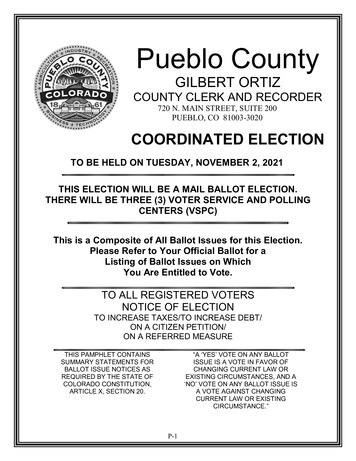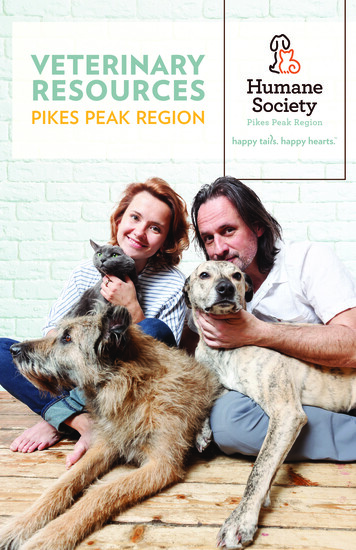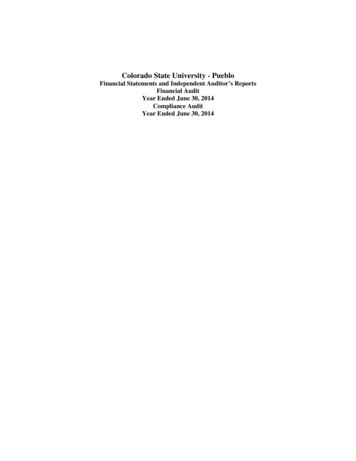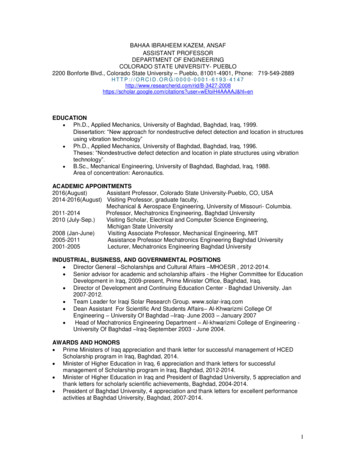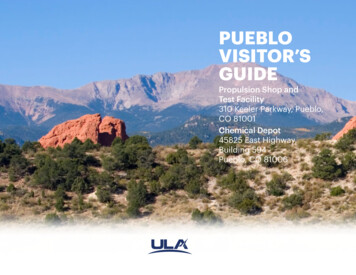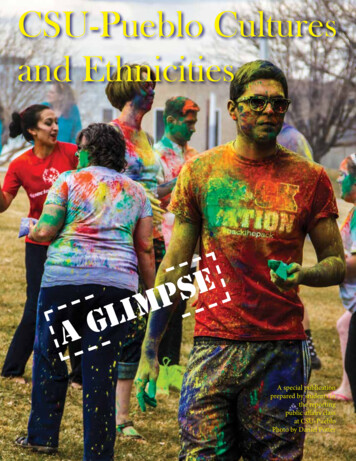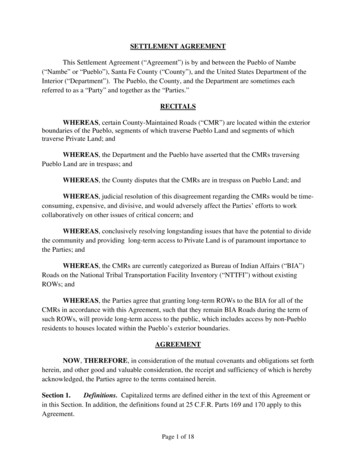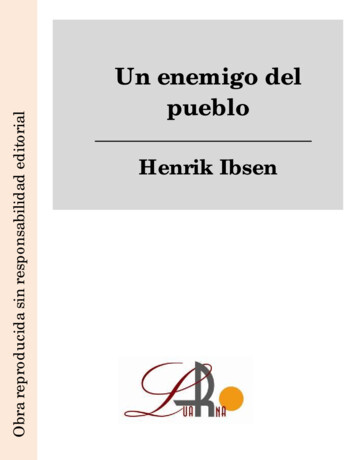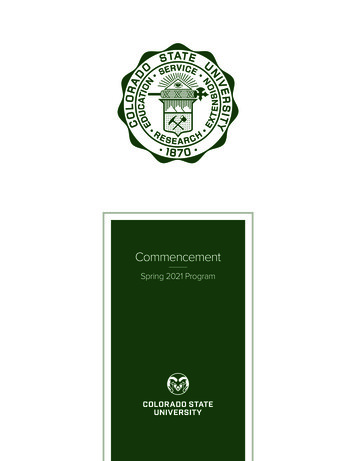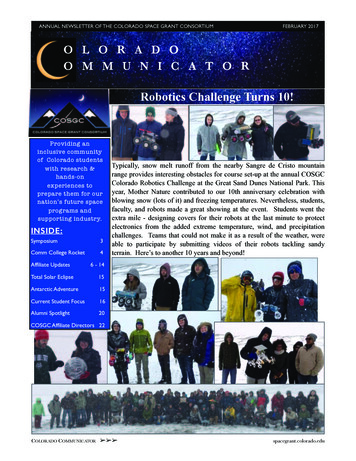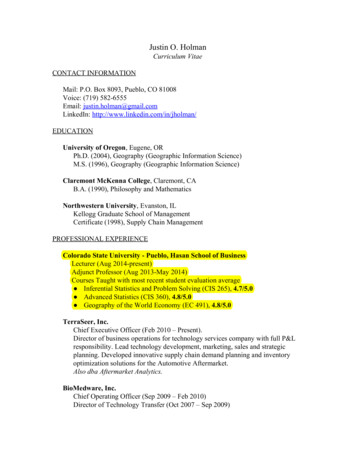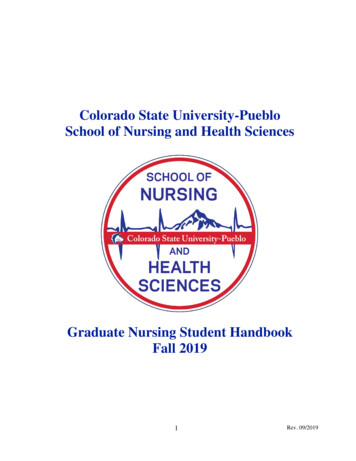
Transcription
Colorado State University-PuebloSchool of Nursing and Health SciencesGraduate Nursing Student HandbookFall 20191Rev. 09/2019
Dear Students,Welcome to the graduate nursing program at CSU-Pueblo!On behalf of the faculty and staff, I would like to welcome you! Congratulations on beingaccepted into the program! Each of you brings uniqueness to the program and you should build onyour strengths and talents in advanced nursing practice as the population ages and health carereforms. Nurse practitioners are playing a vital role in providing affordable and accessible healthcare, especially to vulnerable populations. New nurse educators are replacing the current agingfaculty who are ready to retire as well as increasing the number of nurses prepared to enter theworkforce.The graduate nursing curriculum is rigorous and the faculty is highly qualified and experienced.This is a program that will stretch your intellectual and interpersonal abilities. The School ofNursing and Health Sciences faculty members are experienced clinicians and knowledgeableteachers with the single goal of making each of you the best nurse conceivable. They will guideyou in your efforts to become a professional nurse and share the tools that will help you reach yourfullest potential with the highest standards.Be mindful that learning is a collaborative effort between you and your professors in a professionthat requires lifelong learning.Our doors are always open to you. We are interested in your concerns, questions, and suggestions.Your success in this program is important to all of us. We look forward to the day when you arehooded and begin your new roles in advanced nursing practice.Sincerely,Joe Franta, DNPAssociate Dean of Nursing2Rev. 09/2019
ContentsIntroduction . 5GENERAL INFORMATION . 6History of the School of Nursing and Health Sciences . 6PHILOSOPHY, MISSION, GOALS AND ORGANIZING FRAMEWORK . 8OUTCOMES . 9Program Outcomes: . 9Master’s End-of-Program Student Learning Outcomes . 9Doctorate End-of-Program Student Learning Outcomes . 9PROFESSIONAL STANDARDS . 9Communication . 10Family Education Rights and Privacy Act (FERPA) . 11REFERENCES . 11ACCEPTANCE OF TRANSFER CREDIT . 15Time Limits . 15DEGREE PLANS . 16STUDENT EMPLOYMENT . 16ACADEMIC ADVISING AND REGISTRATION . 16ACADEMIC STANDARDS. 16Grading, Dismissal and Readmission: . 16Course Evaluation Measures: . 17Grading Scale(s): . 17Incomplete Grade Process . 18CLASS AND ON CAMPUS LAB EXPECTATIONS . 20CLINICAL EXPERIENCE . 21Nurse Practitioner Student . 21STUDENT INJURY AT A CLINICAL SITE . 26CLINICAL SITE SCREENING POLICIES . 26Drug Screen Policy. 26Annual Background Checks and Drug Screens . 26Deadlines . 28CLINICAL SITE TECHNICAL REQUIREMENTS . 28CLINICAL PROGRESSION IN THE GRADUATE NURSING STUDENTS AREAS OFEMPHASIS . 29Role of the Student . 303Rev. 09/2019
Role of the Preceptor . 32Role of the Faculty . 33SITE EVALUATIONS . 34Clinical/Practicum Site Evaluation by Faculty . 34Preceptor/ Site Evaluation by the Student . 34Faculty Evaluation of the Student in a Clinical/Teaching Site: . 35REQUIREMENTS FOR GRADUATION WITH A MASTER OF SCIENCE MAJOR INNURSING DEGREE: . 35Non-Thesis Option: Graduate Oral Comprehensive Examination Policy and Process . 36Non-Thesis Option: Graduate Nursing Oral Comprehensive Examination Policy . 36Directed Research Policy and Process . 40Thesis Policy and Process . 40REQUIREMENTS FOR GRADUATION WITH A DOCTOR OF NURSING PRACTICE WITHEMPHESIS IN POPULATION HEALTH . 40DISCIPLINARY ACTIONS . 41Disciplinary Process: Academic. 41Academic/Clinical Improvement Plan (Improvement Plan) . 41Dismissal from the Academic Setting/ Program . 42Disciplinary Process: Clinical . 42Dismissal from the Clinical Setting . 43Grievance, Compliance and Appeal Processes . 43Incomplete Grade Agreement Form . 45Nursing Program Enrollment Agreement Form . 484Rev. 09/2019
IntroductionThe Graduate Nursing Student Handbook contains general information and policies/proceduresthat you will need as you progress through the graduate program. It is to be used as a resource inconjunction with other official documents prepared by Colorado State University-Pueblo. Thegraduate nursing program expands the knowledge and skills of the baccalaureate-prepared nursefor advanced practice, nursing education, research, and leadership roles.The School of Nursing and Health Sciences (SONHS) reserves the right to change, delete, or addinformation to the handbook without previous notice and at its sole discretion. If unanticipatedchanges are needed to the policies in this handbook the revised handbook will be posted in eachBlackboard course and to the CSU-Pueblo School of Nursing and Health Sciences website. Eachenrolled student will be notified via their university email account.Please review the Graduate Nursing Student Handbook and complete the Nursing ProgramEnrollment Agreement Form (Appendix D). You must submit your signed and dated copy to yourCastlebranch account before the last Friday in September of the fall semester.5Rev. 09/2019
GENERAL INFORMATIONHistory of the School of Nursing and Health SciencesThe nursing program at Colorado State University-Pueblo was established in 1964 (then SouthernColorado State College) as an associate degree program. The first class graduated two years later.With the graduation of the first class, the program was accredited by the National League forNursing (NLN).In 1974, the nursing faculty recognized the need for a baccalaureate program in nursing. TheSchool of Nursing and Health Sciences received authorization for an upper division degreecompletion baccalaureate program for registered nurses. In 1975, the state legislature granted thecollege university status and the college name was changed to the University of SouthernColorado. The first graduates from the degree-completion program were awarded baccalaureatedegrees in May of 1977. NLN granted initial accreditation to the degree-completion program in1981. In 2003 the university became Colorado State University – Pueblo. The National Leaguefor Nursing Accrediting Commission (NLNAC) received continued accreditation in 2011.In 2003, the Colorado State University System confirmed approval of the Master of Science with amajor in Nursing (MS) at Colorado State University – Pueblo. The graduate nursing program wasinitially accredited in 2006 by the National League for Nursing Accrediting Commission(NLNAC) and reaccredited 2011. The following master’s program emphasis areas are offered: Adult/Gerontology Acute Care Nurse PractitionerAdult/Gerontology Acute Care / Family Nurse PractitionerPsychiatric-Mental Health Nurse PractitionerNurse EducatorIn 2019, the Colorado State University System confirmed approval of the Doctor of NursingPractice with an emphasis in Population Health. A Candidacy application has been submitted tothe Accreditation Commission for Education in Nursing (ACEN) Standards and Criteria (2017)with a pending ACEN site visit spring 2020.The CSU-Pueblo School of Nursing and Health Sciences graduate program is approved byColorado Board of Nursing, 1560 Broadway, Suite 1350, Denver, CO 80202 and accredited byAccreditation Commission for Education in Nursing (ACEN), 3343 Peachtree Road NE, Suite850, Atlanta, GA 30326. The phone number is (404) 975-5000 and internet address iswww.acenursing.org.6Rev. 09/2019
CSU-Pueblo School of Nursing and Health Sciences Organizational ChartUpdated fall 2019PresidentColorado State University PuebloProvost / Vice President forAcademic AffairsDeanCollege of Education, Engineering andProfessional StudiesAssociate DeanSchool of Nursing and Health SciencesDirector Health SciencesUndergraduateNursing CoordinatorDirector ofAthletic TrainingAT ClinicalCoordinatorGraduate NursingCoordinatorSimulation CoordinatorHS FacultyNursingFacultyStaff:Assistant to the Director7NursingFacultyStaff:Administrative AssistantsGraduate Program AssociatesSimulation TechniciansLab Resources AssistantPre-Nursing Advisor/CounselorUndergrad Retention SpecialistRev. 09/2019
PHILOSOPHY, MISSION, GOALS AND ORGANIZING FRAMEWORKMission Statement: The mission of the School of Nursing and Health Sciences is to preparegraduates for professional positions as safe, competent and caring nurses to meet the healthcareneeds of diverse populations.Philosophy: The Colorado State University-Pueblo School of Nursing and Health Sciences sharesthe mission and philosophy of the University, which focuses on education, scholarly activity, andservice. The SONHS philosophy is dedicated to the pursuit of higher learning grounded in the arts,sciences, and humanities.Caring is considered the central concept of the nursing curriculum. The nursing faculty of CSUPueblo is committed to modeling caring behavior to students on the belief that when studentsexperience caring, they learn to care for others. Caring has been defined as the “essence ofnursing” (Leininger, 1988), a process, and a behavior that can be taught and learned. Caringrequires the “offering of self” (Scotto, 2003); intellectually, physically, psychologically, andspiritually.The faculty ascribes to the core competencies for nurse practitioners and nursing educationidentified by the National Organization of Nurse Practitioners (NONPF), National League ofNursing (NLN), Institute of Medicine (IOM) and the Quality and Safety Education for Nurses(QSEN) project. Nursing is the synthesis of science and art, which addresses health promotion andmaintenance across the lifespan and fosters the development of the nurse’s professional identity,integrity, and leadership. Patient-centered care includes respect for individual dignity andconsideration of cultural and ethical beliefs and values. The nurse advocates for patients andfamilies to promote mutual respect and patient self-management.Nursing care is provided in collaboration with the patient, the family and members of the healthcare team. The nurse displays a spirit of inquiry by examining evidence to improve quality of care,promote safety and improve patient outcomes. Nursing judgment is integral to making competentdecisions related to the provision of safe and effective nursing care. Effective communicationskills using both technological and human means is essential to nursing care.The American Association of College of Nursing (AACN) The Essentials of Master’s Educationin Nursing (2011) and Essentials of Doctoral Education for Advanced Nursing Practice (2006)provide the curricular content and foundation for graduate nursing student learning outcomes.Student centered learning results from the engagement of teacher, learner, and environment ininteractive experiential processes. Varied educational experiences allow the learner to integratethe knowledge, skills, and attitudes required for contemporary professional practice. The faculty isresponsible for facilitating, maintaining, and evaluating the learning process. Learners areexpected to be self-directed, active inquirers who are responsible for their own learning andparticipate in evaluation of educational experiences. The learning helps learners move fromrelative dependence to greater independence in preparation for assuming the professional role andpromoting growth as a life-long learner.8Rev. 09/2019
OUTCOMESProgram Outcomes:1. Eighty percent of graduates will:ooooComplete the program within one and one-half times the length of the program.Express satisfaction with the program.Pass national certification exam the first time.Be employed in role related professional practice within six months to one year.2. Eighty percent (80%) of employers will express satisfaction with the program.Specific student outcomes for each emphasis track are based on national competency expectations.Master’s End-of-Program Student Learning OutcomesAt the completion of the program, graduates will be able to:1. Integrate evidence-based practice, ethical decision making and technology into advancednursing practice.2. Utilize interprofessional collaboration to provide safe, quality patient-centered care.3. Explore quality improvement initiatives that affect delivery of advanced nursing practiceand health care services.Doctorate End-of-Program Student Learning OutcomesAt the completion of the program, graduates will be able to:1. Integrate evidence-based practice, ethical decision making and technology into advancednursing practice2. Conduct scholarly inquiry to influence health outcomes of individuals, aggregates andpopulations3. Organize interprofessional collaboration to provide safe, quality patient-centered care.4. Assume a leadership role in transforming health care systems, policies and standards ofcarePROFESSIONAL STANDARDSStudents are expected to comply with the current CSU-Pueblo, School of Nursing and HealthSciences, Colorado State Board of Nursing and national professional policies, standards andcompetencies.Colorado State University-Pueblo1. University CSU-Pueblo Catalog and Graduate Programs2. Student Code of ConductColorado State Board of Nursing1. Colorado Nurse Practice Act:9Rev. 09/2019
PracticeAct.pdf2. Code of Colorado Regulations (Chapter 14) Code of EthicsStudents are expected to comply with the current provisions published by the American Nurses’Association (ANA) Code of Ethics for Nurses, the Colorado Nurse Practice Act, and the ANAPrinciples of Social Ethics.pdfAmerican Association of Colleges of Nursing (AACN)1.2.3.4.5.6.APRN Doctoral-level CompetenciesEssentials of Doctoral Education for Advanced Nursing PracticeEssentials of Master’s Education in NursingGraduate-level QSEN CompetenciesAPRN Consensus ModelInterprofessional Oral HealthNational Organization of Nurse Practitioner Faculties (NONPF)333321NP Core and Population-focused Nurse Practitioner CompetenciesProfessionalismStudents are expected to comply with 2017 AACN professionalism competencies demonstrating“a commitment to carrying out professional responsibilities and an adherence to ethical principles”(p. 7). All students will dress appropriately and behave in a professional manner at all times in theclassroom, laboratory, practicum and clinical sites while representing CSU-Pueblo Student nursepractitioners in the clinical setting should wear school insignia and/or student identification withphoto badges. A name tag, showing both first and last names, may be requested online. Schoolinsignia may be obtained in the CSU- Pueblo bookstore. Student Photo ID may be obtained in theOcchiato Student Center, second floor.A consistent natural hair color is required in all clinical settings. The student must comply withany specific clothing, hair, tattoo, body piercing restrictions for all clinical settings.Student Nurse Practitioners should wear business casual clothing with a hip-length whitelaboratory coat, unless the clinical site specifies the dress code. Laboratory coat is not required forthe Psychiatric Mental Health Nurse Practitioner or Nurse Educator programs.Students will address faculty, preceptors and other academic and clinical contacts using the propertitle and last name for the contacts degree, profession or otherwise such as “Dr ” or “Professor”.If you are uncertain about the appropriate title, ask the individual how you should address them inan email, personal face to face or other types of communication. Unprofessional behavior mayresult in disciplinary action (CSU-Pueblo Student Code of Conduct, p. 46).CommunicationEffective learning requires communication between faculty, administration and students. CSU10Rev. 09/2019
Pueblo School of Nursing and Health Sciences utilizes several tools to facilitate thecommunication process. Information will be disseminated verbally, electronically using universitye-mail accounts, and/or through Blackboard posting. All email communication should be sent viathe university email system and the subject line should have a course number in the subject lineor it could be deleted without opening. Provide enough background information in the email toensure accurate and timely responses. Students must check their school email on a daily basisduring the week for campus and class announcements. To ensure timey receipt of importantcorrespondence, students must ensure there is space in their inboxes. Students should allow 72hours (three business days) for faculty to respond to e-mail communication. Students are notpermitted to share passwords for email accounts. The clinical communication expectations can befound in the clinical portion of this handbook.Family Education Rights and Privacy Act (FERPA)The SONHS adheres to the Family Education Rights and Privacy Act (FERPA). FERPA governsrequests for access to and release of information from student records. Refer to Registrar’s officefor release forms. Students must maintain current contact information with the university and theSONHS. If changes occur to personal contact information, students must notify the CSU-PuebloRecords Department. The SONHS is not responsible for delay or failure in receiving informationdue to incorrect contact information. (U.S. Department of Education)REFERENCESAmerican Association of Colleges of Nursing (AACN). Common advanced practice registered nursedoctoral-level competencies (2017, October). Retrieved ?ver 2019-02-15-095641-620American Association of Colleges of Nursing (AACN). The essentials of doctoral education foradvanced nursing practice (2006). Retrieved from: can Association of Colleges of Nursing (AACN). The essentials of master’s education innursing (2011). Retrieved from: CNEssentialsAmerican Association of Colleges of Nursing (AACN). QSEN Education Consortium: Graduatelevel QSEN compentencies: knowledge, skills and attitudes (2012). Retrieved tencies.pdf?ver 2017-07-15-135425-900Colorado State University-Pueblo Catalog (2018). Graduate programs. Retrieved olorado State University-Pueblo Catalog (2018). Student Code of Conduct. Retrieved from:https://www.csupueblo.edu/student-affairs/ doc/student-code-of-conduct.pdfLeininger, M. (1988). Leininger’s theory of nursing: Cultural care diversity and universality.Nursing Science Quarterly, 1(4), 152-160. doi: 10.1177/089431848800100408National League of Nursing (2013). Nurse educator core competencies. Retrieved cator-core-competencyNational Organization of Nurse Practitioner Faculties (2016). Criteria for evaluation for nursepractitioner programs. Retrieved from11Rev. 09/2019
http://nonpf.org/displaycommon.cfm?an 1&subarticlenbr 15National Organization of Nurse Practitioner Faculties (2017). Nurse practitioner corecompetencies content. Retrieved from: https://www.nonpf.org/page/14National Organization of Nurse Practitioner Faculties (2013). Population-focused nursepractitioner competencies: Family across the lifespan. Retrieved from:https://www.nonpf.org/page/14National Organization of Nurse Practitioner Faculties (2013). Population-focused nursepractitioner competencies: Psychiatric-mental health (pp. Retrieved from:https://www.nonpf.org/page/14Quality and Safety Education for Nurses (2012). QSEN competencies definitions. Retrieved fromhttp://qsen.org/competencies/U.S. Department of Education (2018). Family educational rights and privacy act (FERPA).Retrieved from: ex.htmlMANDATORY REQUIREMENTS FOR ENROLLMENT/CONTINUATIONIN THE GRADUATE NURSING PROGRAMCSU-Pueblo School of Nursing and Health Sciences utilizes the services of CastleBranch. CastleBranch isa service that allows students to order their own background check and drug screen online. The ComplianceTracker of CastleBranch provides secure, online storage for required documentation such as immunizations,certifications, licensure, background check, and drug screen. All documents submitted must be in PDFformat. Information collected through CastleBranch is secure, tamper-proof, and confidential. Students areresponsible for all CastleBranch costs. Students must always maintain current documentation of mandatoryrequirements throughout the program. Students who are out of compliance are ineligibility to performclinical practicums until requirements are complete. All requirements must remain current in CastleBranchwhile the student is progressing in the graduate nursing program, whether or not the student is in a clinicalrotation. Failure to do so may affect program progression. Mandatory documentation includes:1.Current proof of immunizations including:Tdap-Must provide documentation of a Tdap booster within the past 10 years.Hepatitis B Vaccine (series of three)-Must provide documentation of one of the following: 3 immunization dates Positive titer results showing immunity with either the lab results or verification by aphysicianMeasles, Mumps, Rubella (MMR)-Must provide documentation of one of the following: 2 immunization dates Positive titer results for all three components showing immunity with either the lab resultsor verification by a physicianVaricella-Must provide documentation of one of the following: 2 immunization dates Positive titer results showing immunity with either the lab results or verification by aphysician12Rev. 09/2019
-History of the disease will not be accepted.Flu Vaccine-Must annually provide documentation of a flu vaccine by October 25th of the current flu season,regardless of when the previous vaccine was administered.2.Annual TB Screening.Proof of current (within the last 12 months) TB screening is required prior to attending any clinicalexperiences and annually thereafter. There must be documentation of one of the following: 3.Two-step TB Skin Test (TST). Do this if it is your first TST or more than a year haselapsed since your last TST. The two-step process entails the administration of one TSTand having it read 48-72 hours later, followed by a second TST administered at least oneweek but no more than three weeks (7-21 days) after the first TST and having it read 48-72hours later.At least two consecutive negative annual TSTs, the last TST being dated within the past 12months.QuantiFERON -TB Gold test (lab report required) dated within the past 12 months.T-SPOT .TB test (lab report required) dated within the past 12 months.If positive for TB, provide a clear chest x-ray (lab report required) from within the pastthree years and a TB Questionnaire (available 20Symptom%20Assessment%20Form.pdf.). A new TB Questionnaire is required annually.Current Cardiopulmonary Resuscitation Certification (CPR).A Health Care Provider-C (or equivalent) certification is required.A copy of a certificate of completion or the front and back (signed) of a card must be uploaded toCastleBranch and must be from one of the following courses: American Heart Association BLS for Healthcare Providers American Red Cross CPR/AED for Professional Rescuers and Health Care Providers CPR Pro for the Professional Rescuer from Training Center AMR092Certification from a program other than one of those listed above will not be accepted.4.Physical examination within 12 months prior to enrollment in the Nursing Program.Submit the physical exam form provided by the CSU-Pueblo School of Nursing and HealthSciences. The form is available sical%20Form.pdf. The form must be signed bya health care provider and it must be dated within one year prior to the start of the NursingProgram.5.Urine drug screen completed prior to enrollment in the Nursing Program and annuallythereafter.The test will be ordered when your CastleBranch account is created and paid for at that time. Youwill receive an e-Chain via email. This document must be taken to the LabCorp or Quest locationnearest to you. This will be determined when your order is placed (based on your zip code). Resultsof the drug screen will be housed on CastleBranch (see Drug Screen Policy in the ClinicalInformation section of this handbook).6.Criminal background check completed prior to the Nursing Program orientation and annuallythereafter.13Rev. 09/2019
The criminal background check will be ordered when your CastleBranch account is created andpaid for at that time. No student with a felony conviction related to violent/aggressive behaviorincluding child abuse or domestic violence, drug trafficking, or theft will be allowed in a clinicalagency setting.
In 2003, the Colorado State University System confirmed approval of the Master of Science with a major in Nursing (MS) at Colorado State University - Pueblo. The graduate nursing program was initially accredited in 2006 by the National League for Nursing Accrediting Commission (NLNAC) and reaccredited 2011.
